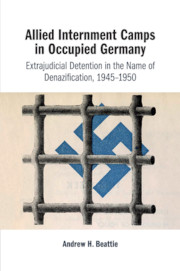 Allied Internment Camps in Occupied Germany
Allied Internment Camps in Occupied Germany Book contents
- Allied Internment Camps in Occupied Germany
- Allied Internment Camps in Occupied Germany
- Copyright page
- Dedication
- Contents
- Illustrations
- Acknowledgements
- Abbreviations
- Introduction
- 1 ‘It Will Be Desirable on Political Grounds’
- 2 ‘Not Consistent with Civil Liberties’
- 3 Internees
- 4 Internment Camps
- Conclusion
- Glossary of German Terms
- Bibliography
- Index
2 - ‘Not Consistent with Civil Liberties’
Internment in Practice, 1945–1950
Published online by Cambridge University Press: 28 October 2019
- Allied Internment Camps in Occupied Germany
- Allied Internment Camps in Occupied Germany
- Copyright page
- Dedication
- Contents
- Illustrations
- Acknowledgements
- Abbreviations
- Introduction
- 1 ‘It Will Be Desirable on Political Grounds’
- 2 ‘Not Consistent with Civil Liberties’
- 3 Internees
- 4 Internment Camps
- Conclusion
- Glossary of German Terms
- Bibliography
- Index
Summary
Chapter 2 examines the practice of internment, from initial arrests through to the closure of the camps. It details how large numbers of internees were arrested through mandatory registrations, raids, or targeted or more random arrests. It then charts how, and how quickly, they were categorized, processed, and released or transferred to another status. The chapter shows that the western powers began releasing significant numbers in 1946, whereas the Soviets did not until 1948. Nevertheless, the chapter argues that the nature and even the speed of internees’ processing differed less than is often assumed. In all zones, internment was distinct from formalized denazification procedures and only a small proportion of internees were tried for individual crimes. Many more were released through administrative processes and various amnesties, often for political reasons. Soviet processes differed primarily in not affording internees opportunities to plead their case or defend themselves with due process. The chapter’s final section confirms the importance of political and broadly defined security considerations in the western zones by discussing the treatment of internees and their families in the context of French deportations from the Saarland in 1946–7 and a British settlement for ‘dangerous’ militarists and Nazis in 1947–8.
Keywords
- Type
- Chapter
- Information
- Allied Internment Camps in Occupied GermanyExtrajudicial Detention in the Name of Denazification, 1945–1950, pp. 60 - 102Publisher: Cambridge University PressPrint publication year: 2019


